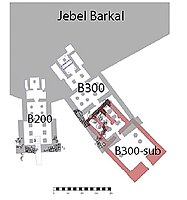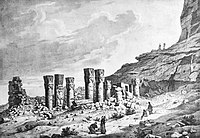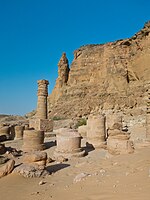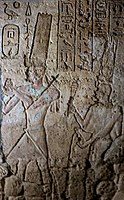Temple Of Mut, Jebel Barkal
History
Restoring a ruined structure abandoned by New Kingdom pharaohs, named B300-sub, Taharqa built an outer temple of cut stone masonry comprising entrance kiosk, pylon, Bes pillars, columns topped with sistrum-headed Hathor capitals and carved five wall painted chambers into the rock base to honor the goddess Mut, who believed to dwell together with the state-god Amun inside Jebel Barkal. From the outer structure only two of the Hathor columns still survive, but the rock-cut chambers are in good shape and were cleaned and restored from 2015 to 2018.
-
Ground plan of the Temple of Mut.
-
View of the ruins of B 300 in 1821 by Frédéric Cailliaud.
-
Ruins of the temple of Mut at the foot of Jebel Barkal.
Setting
The rock-chambers contain restored paintings with representations of Amon, Taharqa and lion-headed or human-headed forms of the Double Crown wearing Mut. The paintings are accompanied by hieroglyphic inscriptions, where Taharqa says that he found the temple built by the "ancestors" in "humble work", and that he rebuilt it as "splendid work". The figures are painted in ochre and white kaolin on a background painted in Egyptian blue. Alluding in some regard to the myth of the Eye of Ra, the goddesses represented in the Temple of Mut played important roles both in the myth of the divine origin of the king and in coronation ceremonies.
Reliefs and paintings
-
View inside the first rock cut chamber of B 300 as it was in 1821 by Frédéric Cailliaud
-
Amun accompanied by Mut with the uraeus-pinnacle shown crowned with a sun disk hanging from the cliff.
-
Taharqa, followed by the sistrum shaking queen Takahatenamun.
-
Taharqa in the Temple of Mut.
-
Lion-headed Mut with Taharqa.
See also
- List of ancient Egyptian sites, including sites of temples
References
- ^ History of temple B300.
- ^ Timothy Kendall, El-Hassan Ahmed Mohammed; A Visitor's Guide to The Jebel Barkal Temples. The NCAM Jebel Barkal Mission; 2016 pp.12-24.
- ^ Jebel Barkal, The Mut Temple Conservation Project.
- ^ Necia Desiree Harkless; Nubian Pharaohs and Meroitic Kings. The Kingdom of Kush; 2006; ISBN 1-4259-4496-5; pp.132-135.
- ^ Timothy Kendall; Napatan Temples: a Case Study from Gebel Barkal. The Mythological Nubian Origin of Egyptian Kingship and the Formation of the Napatan State. Tenth International Conference of Nubian Studies. Rome, September 9–14, 2002.
Sources
- Kendall, Timothy. A Visitor's Guide to The Jebel Barkal Temples (PDF).







